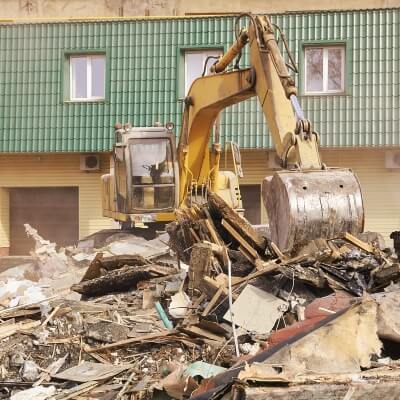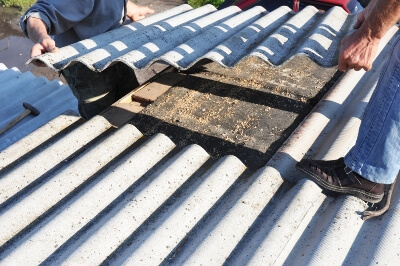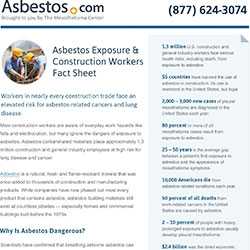Construction Workers and Asbestos Exposure
Construction workers have a high risk of occupational asbestos exposure and of developing mesothelioma. Asbestos found in contaminated construction materials such as paint, spackling, roof shingles, masonry compounds and drywall can be inhaled, which may lead to mesothelioma in construction workers.

Written by Michelle Whitmer • Edited By Walter Pacheco • Scientifically Reviewed By Dr. Jerald L. Cook
Asbestos.com is the nation’s most trusted mesothelioma resource
The Mesothelioma Center at Asbestos.com has provided patients and their loved ones the most updated and reliable information on mesothelioma and asbestos exposure since 2006.
Our team of Patient Advocates includes a medical doctor, a registered nurse, health services administrators, veterans, VA-accredited Claims Agents, an oncology patient navigator and hospice care expert. Their combined expertise means we help any mesothelioma patient or loved one through every step of their cancer journey.
More than 30 contributors, including mesothelioma doctors, survivors, health care professionals and other experts, have peer-reviewed our website and written unique research-driven articles to ensure you get the highest-quality medical and health information.
About The Mesothelioma Center at Asbestos.com
- Assisting mesothelioma patients and their loved ones since 2006.
- Helps more than 50% of mesothelioma patients diagnosed annually in the U.S.
- A+ rating from the Better Business Bureau.
- 5-star reviewed mesothelioma and support organization.
Testimonials
My family has only the highest compliment for the assistance and support that we received from The Mesothelioma Center. This is a staff of compassionate and knowledgeable individuals who respect what your family is experiencing and who go the extra mile to make an unfortunate diagnosis less stressful. Information and assistance were provided by The Mesothelioma Center at no cost to our family.LashawnMesothelioma patient’s daughter
How to Cite Asbestos.com’s Article
APA
Whitmer, M. (2023, June 20). Construction Workers and Asbestos Exposure. Asbestos.com. Retrieved April 19, 2024, from https://www.asbestos.com/occupations/construction-workers/
MLA
Whitmer, Michelle. "Construction Workers and Asbestos Exposure." Asbestos.com, 20 Jun 2023, https://www.asbestos.com/occupations/construction-workers/.
Chicago
Whitmer, Michelle. "Construction Workers and Asbestos Exposure." Asbestos.com. Last modified June 20, 2023. https://www.asbestos.com/occupations/construction-workers/.
How Are Construction Workers Exposed to Asbestos?
The Occupational Safety and Health Administration ranks construction among the most hazardous industries in the United States. With more than 7 million construction workers employed in the U.S., health risks can vary significantly between different work sites.

In 2012, construction was responsible for the highest number of fatal work injuries out of any U.S. industry sector. That year more than 54.2% of all work-related deaths occurred from what OSHA calls construction’s “fatal four”: falls, struck by an object, electrocution and caught in or between hazards.
Workers new to the construction industry may not be familiar with the less obvious risks, including harmful exposure to asbestos. Asbestos exposure causes mesothelioma, a rare and aggressive cancer that can arise several decades after inhaling or ingesting the material.
Construction professionals who worked with asbestos long ago continue to develop asbestos-related cancer and lung diseases to this day. Manufacturers produced housing materials with asbestos until the 1980s and 1990s. It was a popular choice due to its durability and fireproofing properties.
In a 2018 appraisal of construction workers’ health and safety performance, asbestos inhalation ranked highest among fatal injuries at construction sites.
Current laws continue to allow construction companies to use certain asbestos products that meet government guidelines such as roofing felt and coatings, millboard, pipeline wrap, vinyl floor tiles, cement sheets, shingles, pipes and nonroofing coatings. Older and historic construction work, renovations and overseas projects remain especially dangerous.
Trades at risk include:
- Bricklayers
- Bulldozer operators
- Carpenters
- Crane and hoist operators
- Demolition and wrecking crews
- Drywall hangers and tapers
- Home renovators
- Insulation workers
- Laborers
- Pipefitters
- Plasterers
- Plumbers
- Masonry workers
- Roofers
- Tile setters
Asbestos dust can spread around job sites quickly and expose many people in a short amount of time. The toxic dust also clings to clothes, hair and tools, traveling home with construction workers and placing their families in harm’s way. This risk of secondary exposure can also develop into mesothelioma and other asbestos-related diseases.

Bricklayers and Masons
Masonry workers historically would mix raw asbestos into compounds for bricks, stones or blocks. Later, when cutting or demolishing the bricks, the asbestos brick dust would cloud the air. A 2020 study found that removing asbestos-containing materials such as brick can result in asbestos dust concentrations over a thousand times higher than average.
Masonry workers also create asbestos dust by scraping up dry, asbestos-containing mortar and concrete. Airborne asbestos concentrations would escalate even higher when workers used power tools. A 2018 survey ranked masons and bricklayers as the trades with the highest risk of fatal injuries and exposure to hazardous chemicals and materials.
Drywall Workers
Between the mid-1940s and 1977, manufacturers added chrysotile asbestos to joint compound drywall products at levels ranging from 3% to 15%. In addition, drywall tape often contained asbestos. When workers cut drywall panels down to size or fastened them to a building’s framework, they would release asbestos fibers into the air.
Plasterers also patched holes in drywall sheets with asbestos compounds. A 2018 study confirmed that high-pressure drywall removal led to the highest risk of exposure to asbestos fibers, with airborne concentrations several times higher than the permissible level.
Painters
Many painters would spray asbestos-containing spackling compounds on surfaces before they painted them. Several mesothelioma and lung cancer registries have identified elevated disease rates in former painters, indicating that workplace exposures are common.
A number of paints and textured coating products, such as popcorn ceilings, also list asbestos as an ingredient. A 2018 survey ranked painters in the top five trades with the highest exposure to hazardous chemicals and toxic additives.
Roofers
Asbestos shingles pose serious exposure hazards for roofers. These workers often sprayed asbestos-contaminated asphalt cutback or asphalt emulsions onto finished roofs or tore up old roof flashings as they installed new ones. A 2021 report found that asbestos fibers could remain trapped in moss during the weathering of asbestos cement roofs.
Tile Setters
When damaged, asbestos-containing tiles release asbestos fibers into the air and create significant risks for tile setters. In the past, tile setters would mix and spread asbestos grout or disturb the fibers when removing or renovating a building’s flooring. A 2021 study reported that asbestos vinyl flooring contains up to 25% chrysotile asbestos.
Asbestos Products Associated with Construction Workers
A study in the American Journal of Respiratory and Critical Care Medicine estimates that at least 1.3 million construction industry workers are still at risk of occupational asbestos exposure and mesothelioma cancer. Occupational hazards include contaminated paint, spackling, roof shingles, masonry compounds, drywall and many other products.

Over the last century, manufacturers produced thousands of commercial construction materials made with asbestos. Now, countless buildings across the country contain these asbestos materials. The U.S. Environmental Protection Agency suggests that the vast majority of the nation’s 733,000 public and commercial buildings contain asbestos.
Manufacturers typically added asbestos to these products, such as shingles and floor tiles, to make them stronger and fire-resistant. Companies sourced the asbestos from several different providers, but many manufacturers used SG-210 Calidria, Union Carbide’s bulk chrysotile product, as their asbestos component.
- Insulation: Workers sprayed products such as Cafco D and Therm-O-Flake (which contained up to 35% chrysotile asbestos) on steel columns, aluminum sheets and other metal structures needing to withstand high temperatures.
- Flooring: Brands such as American Biltrite, Congoleum and Kentile used asbestos fibers in their flooring tiles. Construction workers often cemented these tiles in place with asbestos mastics and grouts, such as G.W. Berkheimer’s plastic roof cement.
- Roofing: Eternit, Johns Manville, National Gypsum and GAF are companies that made asbestos shingles, and many roofers used CertainTeed asbestos roof coating.
- Drywall: Asbestos drywall products included gypsum board, plasters, millboard and drywall joint compounds. One study found asbestos in all of the taping products and one-third of the patching products the researchers tested.
- Vermiculite Products: Manufacturers continued to produce vermiculite products contaminated by asbestos until the early 1990s.
- Duct Tape: Some duct tape products contain up to 45% asbestos.
- Joint Packing: Historically, joint packing would contain up to 40% asbestos and is still present in many older homes and buildings.
- Construction Felts: Calcot, Syncot and Thermesh manufactured asbestos-containing construction felt products.
- Siding Panels: Transite, Flintkote and National Gypsum produced siding panels containing asbestos fibers.
- Insulating Cement: Careytemp, HiLite, Gum-Bestos and Detrick were producers of asbestos cement products.
- Textured Paints and Ceiling Texturizing Products: These products typically contained less than 5% asbestos but are easily friable when removed.
Manufacturers That Made Products Construction Workers Use
Some of the most popular manufacturers using asbestos in products were W.R. Grace, Johns Manville, Owens Corning and Celotex. Experienced construction workers can sometimes identify asbestos hazards by appearance, labeling, the installer or the manufacturer.
If you are not trained in identifying dangerous products or cannot determine if a product contains asbestos based on the information you have, treat the material as if it does contain asbestos.
Manufacturers of asbestos-containing products Include:
- W.R. Grace: W.R. Grace & Co. manufactured asbestos-containing plaster, cement and insulation, including Zonolite loose-fill attic insulation installed in tens of millions of homes throughout the U.S.
- Johns Manville: Founded in 1858, Johns Manville was one of the first companies to manufacture products with asbestos, including fire-resistant roofing.
- Owens Corning: Until 1972, Owens Corning added asbestos to its ceiling tiles, cement and insulation for pipes, ducts, equipment and cold storage systems.
- Celotex: From the 1920s to the 1980s, Celotex manufactured asbestos insulation and construction materials.
- U.S. Mineral Products: U.S. Mineral Products materials made with asbestos included insulating cement, patching fiber and other fireproofing products.
- Delaware Insulation: This company manufactured asbestos-containing insulation products.
- Brunswick Fabrications: Asbestos-containing products made by fabrication companies such as Brunswick are present in homes, businesses and millions of buildings across the U.S.
- Flintkote Company: The Flintkote Company made asbestos roofing materials from the 1930s until the 1980s.
- Hanson Permanente: This company manufactured asbestos-containing cement.
- Artra Group: Now known as Synkloid, the company used asbestos in its product line between 1949 and 1976.
- Fuller-Austin Insulation: The Fuller-Austin Insulation Company sold, distributed and installed asbestos-containing insulating materials.
- C.E. Thurston & Sons: Thurston installed, repaired, removed and distributed asbestos insulation made by other companies until the late 1970s.
- California Portland Cement: Roland McKinney was a plasterer who died at age 64 of asbestos lung cancer. His family claimed his occupational exposure was due to products manufactured by California Portland Cement.
- Kentile Floors: Kentile produced large, durable vinyl floor tiles made with up to 25% asbestos.
Construction Workers and Mesothelioma
Most occupational health organizations agree that contaminated building products increase a construction worker’s risk of developing asbestos-related diseases.
According to a 2022 report by the European Commission, over 70,000 workers died in 2019 from past exposure to asbestos. A 2018 study indicated that construction workers are more than three times more likely than those in most other occupations to die from mesothelioma.
A 2017 report noted that 20% of air samples collected in the construction industry exceeded the OSHA permissible exposure limit of asbestos fibers. The construction industry accounted for 70% to 80% of asbestos consumption throughout the 20th century, according to the report.
Many studies also note a high number of asbestos fibers in construction workers’ lungs. In an Italian study from 2017, analysts found between 350,000 and 3 million asbestos fibers in each of the workers’ lungs. Construction workers who inhale or ingest asbestos fibers can develop malignant mesothelioma, asbestosis, lung cancer and other asbestos-related diseases.
Research also indicates that construction workers with longer careers have a higher risk of illness. One study funded by the National Institutes of Health found pleural abnormalities in 70% of construction workers who had spent at least 30 years in the field. For many construction workers, it’s essential to find a mesothelioma specialist before developing a severe illness.

View Our Asbestos Exposure & Construction Workers Fact Sheet
Help raise asbestos awareness by printing and sharing this handout, which covers the key facts about asbestos hazards in the construction industry. With more awareness, we can prevent harmful exposures and make worksites safer for everyone.
Construction Workers Share Mesothelioma Survival Stories
A diagnosis of mesothelioma or another asbestos-related disease can be disheartening, but long-term survival is possible. Meet some former construction workers who took advantage of the latest therapies and overcame the odds.
Throughout his 20 years of service in the home improvement industry, Andy frequently worked with asbestos-containing products. Decades later, he learned that workplace exposures to asbestos likely caused the pleural mesothelioma diagnosis he received in 2010.
To improve his prognosis, Andy joined a clinical trial for Amatuximab, an experimental targeted therapy. He responded well to treatment and is now a cancer survivor of more than three years.
When Ward worked as a roofer and steamfitter in his early 20s, he never could have anticipated the mesothelioma diagnosis that would await him more than 50 years later. He was still in good health by then, which helped him qualify for a treatment plan.
Ward’s doctor prescribed pleurectomy and decortication surgery, photodynamic therapy and chemotherapy for mesothelioma. These therapies have helped him survive more than two years past his diagnosis.
Tim believes his 2002 diagnosis of mesothelioma stemmed from past exposures to asbestos in cement and pipes he handled while working on Georgia’s underground water systems.
Although at first Tim declined aggressive treatments such as surgery and chemotherapy, his daughter convinced him to seek treatment. He traveled to Boston for extrapleural pneumonectomy surgery for mesothelioma, which remarkably extended his life 10 years.

Legal Options for Construction Workers Exposed to Asbestos
Construction workers have successfully sued manufacturers of asbestos products that caused them to develop related diseases. They’ve also filed workers’ compensation claims for mesothelioma.
Courts have awarded compensation to workers exposed to asbestos on the job, and many bankrupt asbestos companies have established trust funds for people harmed by their products. These funds have helped patients pay for treatment, travel, lost wages and other out-of-pocket expenses.
Notable Cases and Verdicts
- Insulator Installer
A 2013 case involved an insulator worker and his wife. A California jury decided that asbestos pipes manufactured by Owens-Illinois were defective and hazardous.
When the husband came home from work, his wife would shake out and wash his clothing, exposing herself to asbestos dust. The jury awarded the couple $27.3 million and levied an additional $11 million against Owens-Illinois.
- Union Painter
One notable lawsuit involved a unionized painter who developed mesothelioma in his 60s. The painter spent most of his career painting with texturized topcoats and fillers from asbestos manufacturers such as Union Carbide, Kelly Moore and Bondex.
Instead of settling out of court, he pursued a traditional trial. The jury awarded him an $11 million verdict.
- Construction Supervisor
Another large-scale asbestos lawsuit involved a former construction worker from Florida. The man developed peritoneal mesothelioma after years in his career as a construction supervisor and superintendent.
He recalled handling asbestos compounds and ceiling textures from 14 different manufacturers. These companies included Kaiser Gypsum, Union Carbide and Premix-Marbletite. The construction supervisor’s case also went to trial, where the jury decided on a $14 million verdict.
- World Trade Center Contractor
In 2012, the Supreme Court of New York County upheld a ruling in favor of a contractor who worked on the original World Trade Center. The man spent approximately 15 years cutting and installing asbestos tiles and sheetrock in the towers.
Other workers further contaminated the site with asbestos fireproofing, tape and pipe coverings. The site manager insisted he did not pick out the asbestos products. Still, the court maintained that he failed to protect his workers adequately and awarded the contractor financial compensation.
- Ceiling Tile Installer
A Missouri court of appeals reviewed a case in 2012 filed by a former ceiling tile worker’s widow. Her husband died of mesothelioma, which he developed after working with Bondex drywall products and Simpson Timber ceiling tiles.
The tile installer’s coworkers testified about a snow-like coating of asbestos dust in their workplace, which they recalled getting on their hair, faces and clothing. The initial verdict was $4.5 million, but a jury reduced it after the family settled with one of the manufacturers.
If you are a construction worker diagnosed with an asbestos-related disease, you should consider consulting a qualified and experienced attorney to learn about your options.







